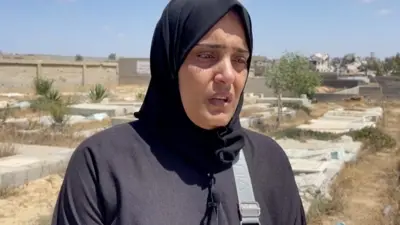We've updated our Privacy and Cookies Policy
We've made some important changes to our Privacy and Cookies Policy and we want you to know what this means for you and your data.
Six children die with Strep A bacterial infection
- By Smitha Mundasad
- Health reporter
Six children have died with an invasive condition caused by Strep A - including five under 10-year-olds in England since September - the UK Health Security Agency has said.
A girl from Wales has also died. No deaths have been confirmed in Scotland or Northern Ireland.
Strep A infections are normally mild but people can become seriously ill.
Parents concerned about their child's symptoms should seek medical advice, the UKHSA has advised.
While still uncommon, there has been an increase in invasive Group A Strep cases this year, particularly in children under 10.
A child from Ealing, west London, and another from Ashford in Surrey, are among those who have died after contracting the infection.
A four-year-old boy, named as Muhammad Ibrahim Ali, from High Wycombe, Buckinghamshire, also died last month.
Primary school pupil Hanna Roap, from Penarth, Vale of Glamorgan, has also died from the infection.
Infections caused by Group A Strep bacteria are usually mild with symptoms like a sore throat or skin infections.
The bug can also cause scarlet fever which can, in the majority of cases, be treated successfully with antibiotics and people make a full recovery.
However, in a very small number of cases, Group A Strep infection can get deeper into the body - for example, into the lungs and bloodstream - causing an illness known as invasive Group A Streptococcus (iGAS), which is much harder to treat.
There are a range of symptoms which may be a sign of an invasive infection, including high fever, poor appetite, dehydration, altered behaviour and feeling very sleepy, according to Dr Colin Brown, deputy director of the UKHSA.
He has advised parents to be on the lookout for these signs and "see a doctor as quickly as possible so that their child can be treated and we can stop the infection becoming serious".
"Make sure you talk to a health professional if your child is showing signs of deteriorating after a bout of scarlet fever, a sore throat, or a respiratory infection," he added.
During the last high season for invasive Group A Strep infection, in 2017-18, there were four deaths in children under 10, compared to the five this year during the same time period.
The latest increase is most likely related to high amounts of the bug circulating and increased social mixing, said the UKHSA.
Dr Elizabeth Whittaker, honorary clinical senior lecturer, at Imperial College London, said: "During the first two years of the pandemic, we saw very little Group A Strep and it has started to circulate again in 2022 as restrictions have been lifted.
"Usually we see a high number of cases in late spring or early summer, often after chicken pox infections. High numbers at this time of year are unusual and probably occurring as normal seasonality has not yet returned.
"Tragically, when there are high numbers of infections, the severe cases will also occur. We are seeing more pneumonia than usual, most likely as group A strep infections are coinciding with the peak in winter respiratory viruses which are typical for this time of year."
As part of its investigations, the UKHSA is also examining reports of an increase in chest infections caused by Group A Strep resulting in severe illness over the past few weeks.
Signs of scarlet fever
The total number of scarlet fever cases also continues to remain higher than would typically be seen at this time of year, according to the latest data.
There were 851 cases reported in the week of 14-20 November, compared to an average of 186 for the preceding years.
Dr Nathalie MacDermott, lecturer at King's College London, said: "Prompt treatment of scarlet fever and Strep throat reduce the chances of a child developing invasive group A Strep and reduce the chances of the infection spreading to other children at school or household members."
The symptoms of scarlet fever include a sore throat, a swollen, red tongue, headache, and fever, along with a fine body rash with a sandpapery feel.
On paler skin, this may look pinkish or red but, on darker skin, it may not have the same colour change.
While most children do recover quickly from scarlet fever, if they deteriorate further, parents are advised to trust their instincts and seek urgent medical advice.
UKHSA advises people to call 999 or go to A&E if:
- your child is having difficulty breathing - you may notice grunting noises or their tummy sucking under their ribs
- there are pauses when your child breathes
- your child's skin, tongue or lips are blue
- your child is floppy and will not wake up or stay awake
There have been 2.3 cases of the invasive Strep A per 100,000 children aged one to four in England this year, compared with an average of 0.5 in pre-pandemic seasons of 2017-19, the agency said.
There have also been 1.1 cases per 100,000 children aged five to nine, compared with a pre-pandemic average over the same period of 0.3.
What is Strep A?
Image source, BSIP/Getty Images
- Group A streptococcal (GAS) infection is caused by strains of the streptococcus pyogenes bacterium
- The bacteria can live on hands or the throat for long enough to allow easy spread between people through sneezing, kissing and skin contact
- Most infections cause mild illnesses such as "strep throat" or skin infections
- It can also cause scarlet fever and in the majority of cases this clears up with antibiotics
- On rare occasions the bacteria can get deeper into the body - including infecting the lungs and bloodstream. It is known as invasive GAS (iGAS) and needs urgent treatment as this can be serious and life-threatening
What is strep A and what are the symptoms?
Most strep A infections are mild, but more severe invasive cases - while still rare - are rising.
Top Stories
Features & Analysis
Most read
Content is not available








